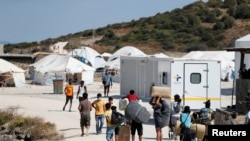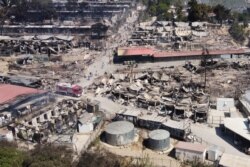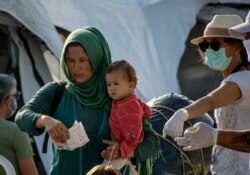For Rahaf al Mohammed, the Moria refugee center was a living hell, but now, after militant arsonists last week razed what has been frequently described as the worst in Europe, she refuses relocation to a new, fenced encampment 10 kilometers south.
“Not good,” the 29-year-old Syrian mother said, “It is like [a] prison. Terrible prison.”
“We went [there] but left [the] next day because [there was] no food, no electricity, no water, and no bottom [to] our tent,” she said, pushing a baby carriage back to Moria. “We slept on dirt and rocks. My babies [are] now sick.”
Independent verification of the conditions at the new, heavily guarded Kare Tepe camp was not possible.
Many of the 12,500 migrants and refugees left homeless after the ferocious blaze, though, attest to the same conditions, forcing most of them to return to Moria, seeking shelter in its chaotic, and now razed, sprawl of tarpaulin tents, crooked prefab structures and the acrid smell of burnt plastic.
Under a scorching Greek sun this week, teams of bedraggled Afghan migrants were seen prying out mangled rods to erect flimsy tents. Others, mainly young men, used a broken irrigation pipe deep in an adjacent olive grove to shower in the open.
“At least here,” said Mohammed Amir, 17, “we are at peace. Small aid groups come and help us. They give us food that we can eat three times a day.
“Inside Kara Tepe,” the Afghan said, “food comes only once, and it is rotten.
“There is no way, I am not going back there,” he said. His four sisters, in colorful head scarves and green plastic face masks, nodded in agreement.
The stakes, though, are high. With more than 13,000 asylum seekers on the island, Lesbos remains a dangerous bottleneck in Europe’s migrant crisis.
Worse yet, the troubled Kara Tepe transfer complicates government efforts to manage the country’s worst humanitarian crisis in five years, when more than 1 million refugees, mainly from Syria, flooded Europe in the biggest migration push since World War II.
Government officials warn they may use force to round up and rehouse all migrants.
In recent days, some 70 female officers in protective white suits and masks were deployed to help move women and children to Kara Tepe.
More than 8,000 were checked in to the new sprawl of crisp white tents by the weekend. It remained unclear, however, whether the camp’s new residents would remain.
“There are many Afghan men going around warning women and children not to resettle because they will burn this camp, also,” Abdirahman Chama, a 38-year-old migrant from Somalia said.
“More importantly,” he said, “if you are out and have a chance to escape this island and go to the West, why go back in?
“I will try to go Germany, but anywhere else will also be good.”
Only recognized refugees can move to another EU member state, a status, together with its documentation, the government has told Lesbos’ homeless asylum seekers they can only obtain as residents of the new camp.
Earlier this week, Germany agreed to take in 1,553 people from 408 families whose protected status has been confirmed by Greek authorities. Belgium and France are expected to follow suit, with the government vowing to empty Lesbos of its refugees by Easter.
Until then, though, locals remain vigilant.
“You think we would be relieved seeing this camp in our backyards destroyed,” said Stelios Panagopoulos, a coffee shop owner in the town of Moria, about a kilometer and a half north of the dreaded refugee camp.
“We are now more scared than ever because militant migrants remain at large, and they are out there hiding in the fields and surrounding mountains, taking revenge on us, slaughtering our livestock and destroying our properties,” he said.
Earlier this year, a farmer from Moria was barred from leaving the country and ordered to pay about $6,000 in fines for firing a warning shot at a migrant intruder. He has since been released and the migrant was detained.
Last week, and after fleeing detention during the camp fire, the migrant returned, allegedly setting fire to the farmer’s barn.
Authorities contacted by VOA suspect he was among the ringleaders of the Moria blaze.
At least seven refugees, including two minors, have been arrested in connection with the fire.
“There is one solution,” al Mohammed, the Syrian mother said, “we [must] all leave. It will be better for all.”












